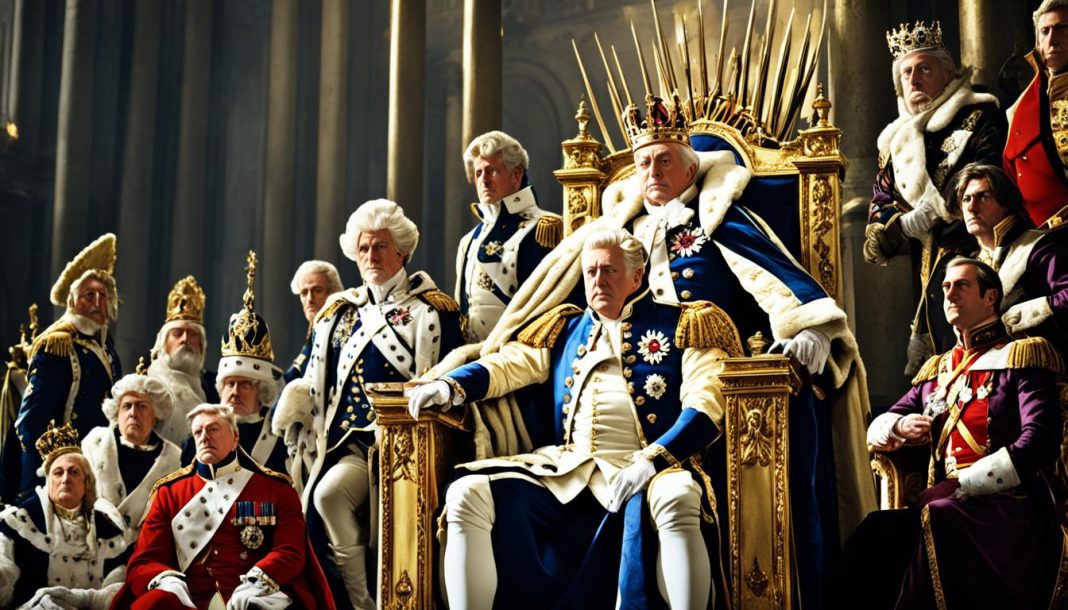King George III: British Monarch’s Impact Story

Did King George III’s reign during the American Revolution truly shape the history of Colonial America? Let’s delve into the life of this historical figure, explore his complex impact on British history, and uncover fascinating facts about King George III.
King George III, born on June 4, 1738, played a significant role during the American Revolution as the King of Britain and Ireland from 1760 until his death in 1820. His reign witnessed crucial events that shaped the relationship between Britain and its colonies in Colonial America. But what were the facts and implications behind his rule?
Key Takeaways:
- King George III’s reign coincided with the American Revolution, with profound consequences for the relationship between Britain and its American colonies.
- He faced political instability, including conflicts within Parliament, which influenced the course of his reign and decision-making.
- King George III’s religious and moral values, rooted in his Anglican faith, shaped his sense of duty as a monarch.
- In the later part of his life, he suffered from recurring mental illness, casting a shadow over his reign and leading to the Regency era.
- King George III’s longest reign in British history resulted in a significant impact on the monarchy, the government’s structure, and British history overall.
Early Life and Education
Prince George, the future King George III, was born on June 4, 1738, in Norfolk House, located in St James’s Square in London. He was the first son of Frederick, the Prince of Wales, and Augusta of Saxe-Gotha. From an early age, Prince George was surrounded by the influence of his parents and their circle, which shaped his upbringing.
Prince George received a comprehensive education that encompassed a wide range of subjects. His studies included science, astronomy, mathematics, French, Latin, history, and music, among others. This well-rounded education provided him with a solid foundation for his future role as a monarch.
Furthermore, Prince George developed a strong interest in Anglicanism during his formative years. His religious beliefs were deeply influenced by this early exposure, impacting his values and guiding his actions throughout his life.
Accession and Marriage
On October 25, 1760, George III ascended to the throne of Great Britain and Ireland following the death of his grandfather, George II. This marked the beginning of his long and eventful reign as a British monarch.
In 1761, King George III married Charlotte of Mecklenburg-Strelitz, a German princess. Their union was a love match and they had a strong affection for each other throughout their marriage, which lasted for over 50 years.
The couple resided in Buckingham House, a grand townhouse located in Westminster, London. Over the years, Buckingham House underwent extensive renovations and expansions, eventually transforming into the iconic Buckingham Palace, the official residence of the British monarch.
George III and Charlotte of Mecklenburg-Strelitz’s marriage was not only a personal union but also a strategic one, cementing international alliances and strengthening the position of the British monarchy. Together, they had 15 children, and their descendants would go on to play significant roles in European royalty.
Early Reign
King George III’s early reign was marked by a series of military conflicts that had a profound impact on the British Empire and its relationship with its American colonies. One significant event during this period was the Seven Years’ War, which took place from 1756 to 1763.
The Seven Years’ War, also known as the French and Indian War in North America, was a global conflict that involved major European powers, including Great Britain and France. It had far-reaching consequences for the British Empire, as it solidified Great Britain’s dominance in North America and India.
In North America, Great Britain gained control of key territories, including Canada and various colonies along the eastern seaboard. However, the war also left the British Empire burdened with a staggering amount of debt, paving the way for future tensions with its American colonies.
In the later part of King George III’s reign, there were significant developments related to the institution of slavery and the transatlantic slave trade. In 1807, the British Parliament passed the Slave Trade Act, effectively banning the transatlantic slave trade throughout the British Empire.
This landmark legislation was a significant step towards the abolition of slavery and demonstrated the changing societal and political attitudes towards this inhumane practice.
By the end of his reign, King George III had presided over a period of immense change and upheaval, both within the British Empire and in its relationships with its American colonies.
Consequences of the Seven Years’ War
The Seven Years’ War had profound consequences for the British Empire and its American colonies. While Great Britain emerged as the dominant power in North America and India, the war had strained the relationship between the colonies and the mother country.
The enormous debt incurred during the war led to increased taxation on the American colonies, which ultimately contributed to growing tensions and the eventual outbreak of the American Revolution. The outcome of the Seven Years’ War set the stage for the conflict that would shape the future of Colonial America and ultimately lead to its independence.
Political Instability, 1760-1770
The early years of King George III’s reign were marked by political instability, as different factions within Parliament vied for power and disagreements arose over the handling of the Seven Years’ War. The political landscape was shaped by the involvement of the king and his choice of ministers.
Prime Ministers: Lord Bute, George Grenville, and the Duke of Newcastle
During this period, several prime ministers faced challenges in leading the government. Lord Bute, who served as the king’s first official prime minister, faced criticism and opposition from the Whigs and other political factions.
“I’m convinced in my own mind that ministers will ever change unless the administration is changed.”
George Grenville, known for his fiscal policies and introduction of the Sugar Act, faced opposition from both the Whigs and the Tories. His attempts to increase revenue in the American colonies were met with resistance and ultimately contributed to the growing tensions that led to the American Revolution.
“It’s my duty to act for the benefit of the whole empire, and not for any particular part.”
The Duke of Newcastle, who served as prime minister before and during King George III’s reign, faced challenges in managing alliances and balancing the interests of different factions within Parliament.
King George III’s Involvement:
The king played a significant role in the political landscape of the time. He had a strong influence on the selection and dismissal of ministers, as well as the formation of policies.
“It is an essential part of my duty, for the sake of my people, to exclude any person whatever from a share in the direction of my councils whose conduct in public life may have rendered him unworthy of my confidence.”
This involvement of the king in politics and his choice of ministers contributed to the instability and challenges faced by the government during these early years of King George III’s reign.
The American Revolution
King George III’s reign coincided with the American Revolution, a significant event that shaped the relationship between Britain and its American colonies. Key acts, such as the Townshend Acts and the Coercive Acts, heightened tensions between the colonies and the British Empire.
The Townshend Acts, passed in 1767, imposed taxes on various imported goods, including glass, paint, paper, and tea. These acts were met with resistance and boycotts in the colonies, initiating a period of growing discontent.
The passage of acts like the Townshend Acts and the Coercive Acts heightened tensions between Britain and its American colonies.
The Coercive Acts, also known as the Intolerable Acts, were implemented in response to the Boston Tea Party. They aimed to punish the colonists and regain control over Massachusetts. The acts included the Boston Port Act, which closed the port until the destroyed tea was paid for, and the Massachusetts Government Act, which limited self-governance.
The First Continental Congress, convened in 1774, brought together representatives from the colonies to discuss their grievances and form a unified response to British policies. The congress marked a significant step towards colonial unity and resistance against British authority.
The king’s position on American policy and his relationship with Prime Minister Earl of Guilford impacted the course of the revolution.
Prime Minister Earl of Guilford, also known as Lord North, played a crucial role in shaping British policy towards the American colonies under King George III’s reign. Known for his conciliatory approach towards the colonies, Guilford’s policies sought to find a peaceful resolution to the escalating tensions.
The Earl of Guilford’s Approach
Guilford believed in repealing some of the oppressive measures imposed on the colonies, offering concessions, and encouraging dialogue. His efforts aimed to restore harmony between the American colonies and Britain.
George III’s Religious and Moral Values
King George III, as a devout Anglican, held strong religious and moral values throughout his reign. These deeply ingrained principles shaped his sense of duty as a monarch and influenced his expectations for the behavior of those around him.
George III’s steadfast adherence to Anglicanism guided his decision-making and actions, serving as a moral compass in his role as the ruler of Great Britain and Ireland. His strong sense of duty compelled him to uphold the moral standards he believed were essential for a monarch to embody.

These religious and moral values, which formed the foundation of George III’s character and reign, played a significant role in his interactions with both his family and his friends. He had high expectations for their behavior and held them to the same moral standards that he imposed upon himself.
George III’s commitment to his Anglican faith, coupled with his sense of duty and unwavering moral standards, influenced not only his personal life but also the decisions he made as a monarch. These values served as a guidepost during his reign and left a lasting impact on the British monarchy.
Mental Illness and Regency
In the later part of his life, King George III experienced a challenging battle with recurrent and eventually permanent mental illness. The exact nature of his condition remains debated among historians and experts. However, two potential illnesses that have been suggested are bipolar disorder and porphyria.
“The mental health struggles of King George III have long been a subject of intrigue and debate,” says historian Dr. Elizabeth Thompson. “His symptoms, including periods of mania and depression, align with characteristics of bipolar disorder. Additionally, the possibility of porphyria, a rare metabolic disorder, cannot be ruled out.”
King George III’s mental health decline manifested in numerous ways, impacting his ability to fulfill his regal duties effectively. In 1810, the king experienced a final relapse that left him incapacitated. Consequently, his eldest son, the Prince Regent, assumed the role of ruler, becoming George IV.
This challenging chapter in King George III’s life had a profound effect on the monarchy and the country. The Prince Regent’s assumption of power as George IV marked a significant shift in the royal lineage and the governance of the British Empire.
Legacy and Longevity
King George III holds a remarkable place in British history as the longest-reigning monarch, ruling for an impressive 59 years and 96 days until his death. His reign spanned the Georgian and Regency eras, leaving an indelible impact on the monarchy and shaping the course of British history.
As the longest-reigning British monarch, King George III played a pivotal role in the transformation of the British monarchy. His enduring presence on the throne allowed him to witness significant social, political, and economic changes within the nation.
Furthermore, King George III holds the prestigious distinction of being the longest-lived male monarch in British history. His longevity symbolizes the resilience and endurance of the British monarchy.
Through the Georgian and Regency eras, King George III’s reign witnessed crucial historical events and developments. From the American Revolution to the rise of industrialization, his monarchy played a critical part in shaping these transformative periods.
The legacy of King George III as the longest-reigning and longest-lived male monarch endures even today. His enduring presence in British history serves as a testament to the strength and resilience of the royal institution, leaving an indelible mark on the legacy of the British monarchy.
Impact on British Monarchy
During King George III’s reign, the British monarchy underwent significant changes, leading to the establishment of a constitutional monarchy. This shift resulted in a redistribution of power, with executive authority being exercised by ministers rather than solely by the monarch. As a result, King George III’s role became more ceremonial in nature.
Although the king still played a significant role in shaping policies and selecting ministers, the government began to operate through a ministerial system. This system allowed for greater accountability and a division of powers within the monarchy.
Overall, King George III’s reign marked a transition towards a constitutional monarchy, with the executive power being vested in the hands of ministers. This change had a lasting impact on the functioning of the British monarchy and the governance of the nation.
Conclusion
King George III’s reign as a British monarch had a profound impact on Colonial America and the British monarchy. His complex legacy continues to be studied and debated by historians. During his rule, the relationship between Britain and its colonies became increasingly strained, ultimately leading to the American Revolution. The political landscape of the time was marked by political instability and disagreements over policies.
Despite the controversies and challenges of his reign, King George III remains a prominent historical figure in the British royal family. His long-lasting impact on the monarchy, as well as the history of Colonial America, cannot be overlooked. His reign saw the shifting dynamics of power within the British monarchy, with a move toward a more constitutional monarchy where executive power was exercised by ministers.
King George III’s reign serves as a testament to the complexities of governance and the challenges faced by colonial powers. His story sheds light on the struggles and consequences associated with empire building. Whether he is seen as a tyrant or a misunderstood ruler, King George III’s reign continues to shape our understanding of the British monarchy and its place in the history of Colonial America.
Thanks For Reading…King George III: British Monarch’s Impact
How much did you like King George III: British Monarch’s Impact? Please share your views in the comment box. Also, please share this story with your friends on social media so they can enjoy it, and for more such stories, please bookmark storiespub.com.
Check out other stories that we have:
























